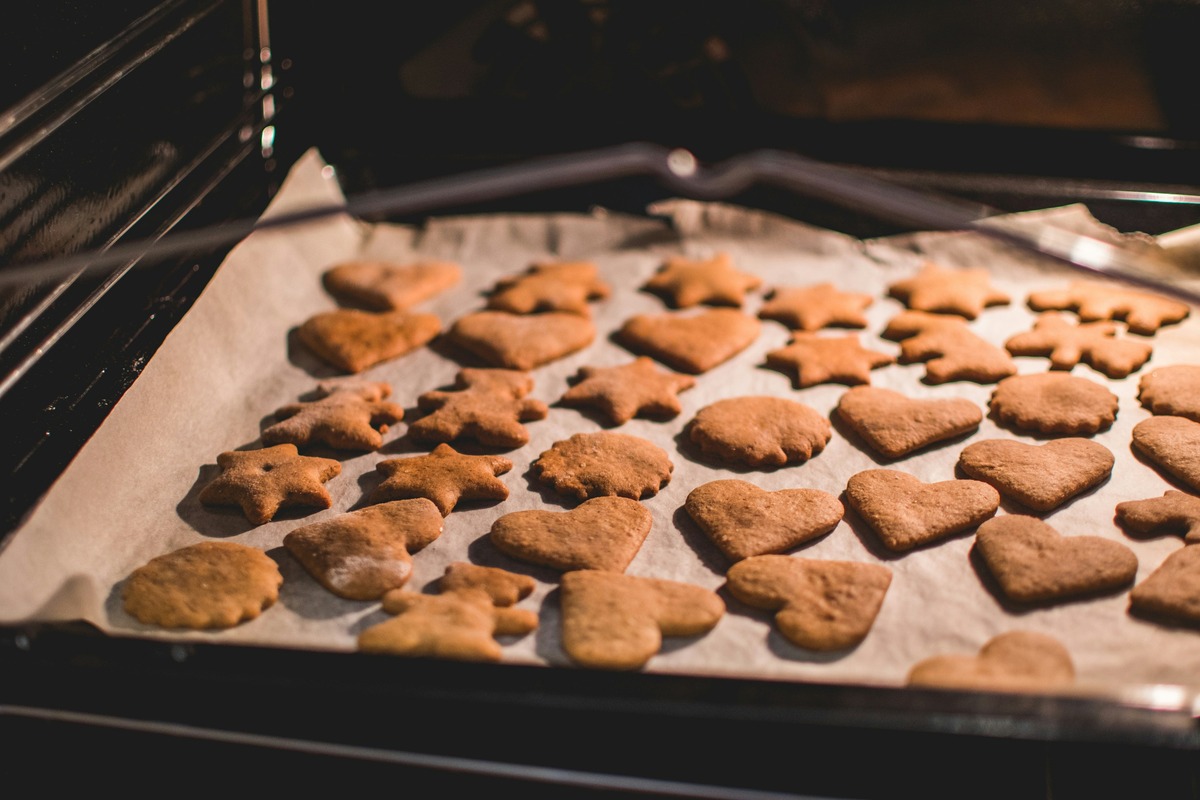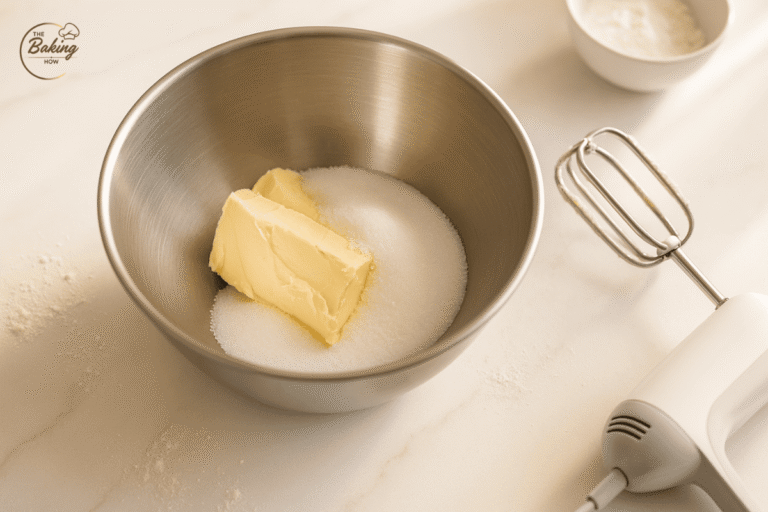7 Common Cookie Baking Mistakes Beginners Make (and How to Avoid Them)
As a beginner, cookie baking mistakes are common, but don’t worry, you are not alone. With my 17 years in the biscuit and cookies industry, I have seen these mistakes happen again and again and good news is, they are easy to fix once you know how to avoid these mistakes.
Whether you are baking at home for fun or planning to turn your passion into a small business, avoiding these common cookie baking mistakes can save your time, ingredients and a lot of frustration.
In this article we will discuss 7 beginner cookie baking mistakes and how to fix them with simple practical tips based on real baking experience.
Check out Our Blog: baking tools for cookies
1. Using Cold or Overheated Ingredients
The temperature of your ingredients plays a crucial role in cookie dough mixing.
If you use cold butter or eggs straight from the fridge, the dough becomes stiff and won’t mix properly. This results in cookies that don’t spread and turn out dense or dry.
On the other hand, if your butter is too warm or melted, the dough gets too soft — causing the cookies to spread too much, become flat, and lose their shape during baking.
Perhaps the most visible result of using warm ingredients or skipping the chilling process is cookies that spread into thin, greasy discs. If this sounds familiar, I have a dedicated guide that explores all the reasons why your cookies might be flat and how to prevent it
Pro Tip:
Always keep your butter and eggs at room temperature for about 30 minutes before mixing. In commercial baking, we always check butter softness with finger press.This helps the dough come together smoothly and gives you evenly baked cookies with the right texture and shape .

2. Overmixing (or Undermixing) the Dough
After ingredient temperature, the way you mix the dough is just as important in cookie baking.
If you add all the ingredients at once, the dough often turns too sticky and becomes difficult to handle. That’s why it’s important to add ingredients in stages , with flour added last to control the texture.
Mixing the dough for too long activates gluten, which leads to a harder dough. The result? Cookies that are dense, chewy, and often shrink while baking.
On the other hand, if the dough is under mixed, it won’t bind well. This leads to rough, crumbly dough and misshaped cookies with uneven texture.
Pro Tip:
Mix until all the ingredients are just combined, no more, no less. Once the flour disappears into the dough, stop mixing to avoid gluten development.
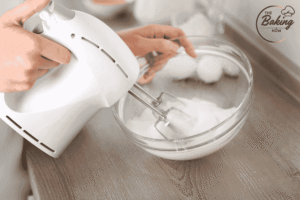
3. Using the Wrong Measuring Tools
When it comes to baking cookies, accurate ingredient measuring is essential. Even a small mistake in measurements can ruin the texture, shape, or taste of your cookies.
If the ingredient ratios are not balanced, your cookies may turn out too dry, too sweet, or completely misshaped. That’s why you need the right tools for the job.
If your recipe calls for “cups,” use standard measuring cups for dry ingredients and liquid measuring cups for wet ingredients — never interchange them.
If the recipe is given by weight (in grams), always use a digital kitchen scale for precision. In my biscuit factory, we always use digital scales for every batch even for ingredients like baking soda or vanilla essence. Consistency is the secret to success.
How to measure baking ingredients properly
Pro Tip:
I recommend investing in a reliable digital scale — it’s affordable and can be used for all baking needs, especially when following commercial-style recipes.

4. Skipping or Incorrect Preheating of the Oven
Preheating your oven is a critical step in baking cookies and skipping it leads to underbaked or unevenly textured cookies.
If you place your cookie tray into a cold or partially heated oven, the dough warms up too slowly. This causes the outside to firm up while the center stays underbaked. As a result, cookies become hard on the edges and doughy in the middle.
Also, when you open the oven door to place the tray, you lose some heat so it’s smart to preheat the oven to a slightly higher temperature (around 15–20°C more than the recipe suggests), then reduce it to the exact baking temperature after inserting the tray.
Pro Tip:
Preheat your oven for 10–15 minutes before baking, and always use an oven thermometer if possible, especially for home ovens that often show inaccurate readings.
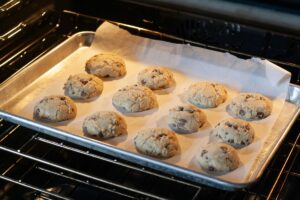
5. Opening the Oven Door Too Early
As we discussed in the previous section, maintaining the correct oven temperature is critical for cookie baking.
One of the most common mistakes beginners make is opening the oven door too early, especially during the first few minutes of baking. This sudden drop in temperature affects the cookie’s rise, texture, and even color.
During the early baking stage, cookies are still developing. If you open the oven at this time, the heat escapes and the cookies may turn out dense, underbaked, or unevenly spread.
In our commercial baking process, we always track the start time and avoid checking before 8–10 minutes of baking. You can apply the same principle at home: note your start time and resist opening the oven door until cookies are nearly done.
Pro Tip:
Use your oven light to check the cookies, and avoid opening the door until the cookies look mostly set , then you can test doneness in the final 1–2 minutes.
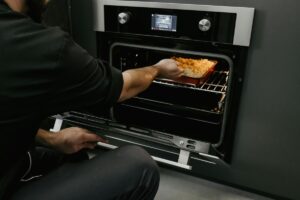
6. Using the Wrong Baking Tray
The material and thickness of your baking tray can greatly affect how your cookies turn out.
If you use a tray that is too thin, it heats up quickly — causing the bottom of the cookies to burn or stick to the tray. On the other hand, a tray that’s too thick may not transfer heat evenly, leaving the cookies undercooked and chewy in the center.
Always choose a light-colored, non-stick baking tray. These reflect heat more gently and help ensure even baking.
For even better results, use parchment paper. It prevents cookies from sticking, protects the bottom from overbaking, and makes cleanup easier.
Pro Tip:
Avoid dark-colored or cheap metal trays , they absorb too much heat and often cause cookies to overbrown at the base.

7. Not Letting Cookies Cool Before Handling
After baking, it’s tempting to touch or move the cookies right away , but that’s a common mistake that leads to broken or misshaped cookies.
Freshly baked cookies are fragile because their structure hasn’t fully set yet. If you try to remove them too early, they may crack, crumble, or fall apart.
Always let the cookies cool on the baking tray for at least 5–10 minutes. This resting time allows the heat to settle and the texture to firm up.
In our commercial biscuit factory, we wait the same amount of time as the baking cycle. If cookies are baked for 10 minutes, we let them cool for 10 minutes before moving them to packaging.
Pro Tip:
After the initial cooling, transfer cookies to a wire rack so air can circulate and prevent sogginess from trapped steam.

Conclusion: Avoid These Cookie Baking Mistakes for Perfect Results
Baking cookies can be fun, rewarding, and even therapeutic , but beginner cookie baking mistakes can ruin your efforts and waste ingredients.
As someone with over 17 years of experience in the biscuit and cookies industry, I have seen these common issues again and again , and I can confidently say: they are all easy to fix with the right approach.
By managing things like ingredient temperature, oven preheating, measuring accuracy, and baking tray selection and by giving your cookies time to rest. You will start baking cookies that are evenly shaped, soft or crispy as desired, and full of flavor.
Now that you know how to avoid these cookie baking mistakes, you’re ready to enjoy consistently better results at home , whether you’re baking for your family or building your own small baking business.
Cookies Baking Tips for Beginners


